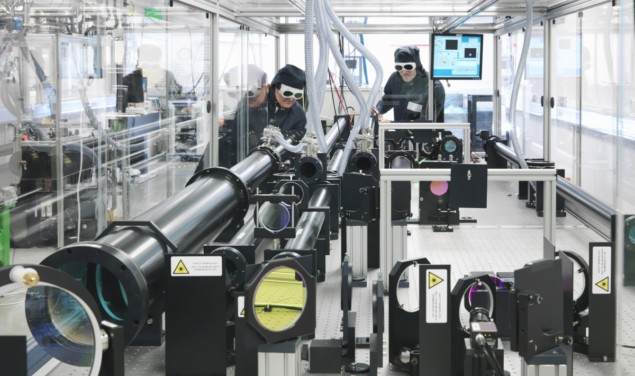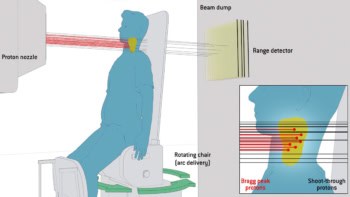
Researchers at Queen’s University Belfast (QUB) have developed a novel tool that uses a combination of high-power lasers and selective ion acceleration to investigate the biology of potential future radiotherapy regimes.
The QUB team used lasers in the Gemini laser facility at Rutherford Appleton Laboratories, UK to focus an extremely intense, ultrashort 40 fs laser pulse onto ultrathin carbon foil targets – instantly ionizing and transforming them into a plasma of protons, carbon ions and electrons. At these extreme intensities, the laser pulse is able to push the plasma electrons forward by radiation pressure, which accelerates the carbon and protons.
The researchers demonstrated that by optimizing the thickness of the target, they could selectively accelerate carbon nuclei in the target material with respect to the lighter protons. A target thickness of 15 nm produced maximum carbon ion energies of 33 MeV/nucleon (approximately 400 MeV), as well as minimizing the acceleration of protons (18 MeV).
This preferential acceleration of heavier species over protons is atypical of acceleration mechanisms known to act on multispecies targets. To investigate the reason for this, the researchers performed further experiments and computer simulations of the acceleration process. They found that the two ion species are accelerated via different mechanisms, which arise due to the intensity profile of the Gemini laser pulse – in which the main pulse is preceded by a short pedestal and rising edge.
At the ideal target thickness, the very early part of the laser pulse reaching the target is intense enough to create the plasma and drive the protons out of it. When the main pulse arrives, it then accelerates the remaining carbon-dominated target. The team publish the results in Physical Review Letters.
Lead author Aodhan McIlvenny, a research fellow at QUB, explains that the team uses these unique radiation sources to investigate ultrahigh-dose-rate radiobiology – an extension to the “FLASH” regime – a technique that delivers radiation at far higher dose rates than existing treatments. According to McIlvenny, this has so far been explored with electrons and protons, but high-power laser–solid interactions also offer a source of ultrahigh-dose-rate higher-mass ions – such as carbon ions – that are able to deliver their energy at dose rates orders of magnitude higher than any conventional form.
“The FLASH regime is currently being explored as a means of delivering high doses for cancerous cell killing – but is also thought to reduce the damage to healthy tissue, which would lead to reduced side effects,” McIlvenny explains.
“This is what we explore with radiobiology studies – looking at cell models, exposing them to laser-driven radiation and comparing it to standard sources. Carbon is of particular interest as it is known to be better for the treatment of some cancers which are resistant to other forms of radiation,” he adds.
Simple cells
At this stage, the QUB team continues to work with relatively simple cell models, and McIlvenny is keen to stress that the new technique has not yet been used in a clinical setting and is definitely not suitable for use with any patients currently.
“So far, we have mostly shown that laser-driven protons have the same cell killing abilities as those from standard sources. The biology at these dose rates is yet to be fully explored and the mechanisms are yet to be understood, but we hope to test whether they are beneficial for reducing side effects in healthy tissue so that we can help develop more effective treatments in the future,” he says.

Proton FLASH study wins best abstract award at ESTRO congress
In a radiotherapy context, it is particularly important to reduce damage to healthy tissues surrounding a tumour deep in the body. Particle therapy, using protons and carbon ions, offers advantages when treating some cancers as these particles deposit the majority of their energy at a specific depth so the dose can be localized. X-rays, the main radiotherapy approach employed currently, will unavoidably deposit energy in healthy tissue as they propagate through the body, which can cause some unwanted damage. “So, we are investigating the use of ions, but with an ultrahigh dose rate to see if there are any additional benefits,” McIlvenny adds.
Although the QUB team already works with the highest power lasers currently available worldwide, McIlvenny also reports that “even higher power lasers are coming online across the US, Europe and Asia in the next few years” – and confirms that he and his colleagues hope to use these beams to produce more and higher-energy ions to extend their range of studies.
“In the meantime, we are planning to investigate methods to optimize this source and investigate new mechanisms while exploring the complex physics of high-power laser–matter interactions,” says McIlvenny.



